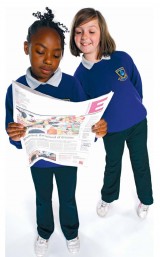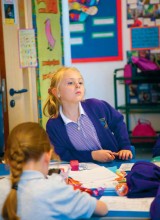It's good for children to be nosey, says Stephen Bowkett and Simon Percival...
Imagine the following conversation between two Y6 pupils (or Y5, or Y4…) What do you think is going on?
Tom: I’m sad when I’m at school.
Hannah: So what is it that you want?
Tom: Not to be sad when I’m at school.
Hannah: OK, so what is it that you want?
Tom: To be happy at school.
Hannah: What does ‘happy’ mean to you?
Tom: Smiling and laughing, feeling like everybody is your friend.
Hannah: So, what would it be like to be happy at school?
Tom: I would enjoy lessons and work with different friends. Breaktimes would be full of games and fun.
Hannah: When you think about that, what do you see, hear and feel?
Tom: I see lots of smiles. And the sun is shining. I can hear lots of chatter, excited but not silly so the teacher doesn’t tell us off! There would be laughing and singing at break. It feels great.
Hannah: What is ‘great’ like?
Tom: Like I’m filled with sunshine.
Hannah: So what you want is to be happy at school, to see smiling faces, to hear the sound of fun and laughter and to feel great, like you’re filled with sunshine?
Tom: That’s it!
This is a transcript of a ‘coaching conversation’. Hannah and most of the other pupils in the class reached this degree of competency after a couple of days’ training. Notice how even such a brief intervention helps Tom to explore, focus and direct his thoughts and feelings, orienting him not only towards a desired goal but also providing him with a means to realise insights and solve problems in order to achieve it. Further aspects of this and other pupil-based coaching conversations include:
• Absence of teacher intervention.
• The asking of open questions by the coach.
• A high degree of attentiveness by the coach to the particular language used by the ‘coachee’.
• An implicit assumption (which the teacher may previously have made explicit to the whole class) that the children are more resourceful and creative than perhaps they thought they were.
• The absence of advice (‘should / could’ language) from the coachee.
• Mutual respect between coach and coachee.
 Developing the social and emotional aspects of children’s learning, their so-called ‘Emotional Intelligence’ (EI), has long been recognised as a centrally important feature in maximising both achievement and enjoyment in learning. It can also have a huge impact on other areas of their lives beyond the school gates, now and in later life.
Developing the social and emotional aspects of children’s learning, their so-called ‘Emotional Intelligence’ (EI), has long been recognised as a centrally important feature in maximising both achievement and enjoyment in learning. It can also have a huge impact on other areas of their lives beyond the school gates, now and in later life.
In this and subsequent articles, we will offer tips and activities for developing EI through the use of the principles and techniques of life coaching. Specifically we will focus on the five key areas of:
• Self-awareness
• Innovative and inventive thinking
• Independent enquiry
• Collaborative learning
• Communication skills
These build toward an attitude in children whereby they become the active co-creators of their own learning, underpinned by the general principle of ‘being nosey’, by which we mean the evolving skills of noticing and questioning.
Creativity remains a vital component of learning. It involves making fresh connections and looking at ideas from a multiple perspective. Encouraging these in a ‘safe’ way develops children’s confidence: you can then rehearse them in more subject-specific and challenging contexts.
For instance, show the class the image below. Explain that it is a bronze artefact unearthed by archaeologists. Nobody knows for sure what it is or was used for. Ask the class to come up with suggestions.
 After gathering some ideas say ‘What if the object was the size of this room?’ Such a change of perspective will likely generate more thoughts. Then shrink it to the size of a golf ball. What might it be used for now?
After gathering some ideas say ‘What if the object was the size of this room?’ Such a change of perspective will likely generate more thoughts. Then shrink it to the size of a golf ball. What might it be used for now?
Encourage creative connections by asking children to link pairs of unlikely objects or concepts. So, for example, what links can they make between a cat and a rose? Or between a pencil and the M6? Or between happiness and a light green salad? Extend the activity by either asking children to come up with their own pairs, or write individual ideas on scraps of paper that you then put in a bag and draw out at random.
Develop the game further by laying out on a table a range of objects and / or ideas written on scraps of paper and ask children to pick three that have something in common. Afterwards, ask groups to make one of the objects an odd-one-out.
 The what-if game is great for ‘big scale thinking’ and inventiveness. You can also suggest scenarios in the form of moral dilemmas, which develop empathy and reflective thinking, such as the one below.
The what-if game is great for ‘big scale thinking’ and inventiveness. You can also suggest scenarios in the form of moral dilemmas, which develop empathy and reflective thinking, such as the one below.
What if people changed colour depending on the feelings they experienced? As well as going red with anger, or white with fear, we actually turned green with envy or yellow with cowardice. Ask children to discuss which colours would suit a range of different emotions.
In this case the underpinning question might be ‘How would this scenario change people’s behaviour?’ Depending on the other what-ifs you use, you can ask these subsidiary question: what would the world be like? What problems would we face? How could we solve those problems?
Here are a few other what-ifs that work well.
• What if all people over 35 started to shrink, so that by the time they were 65 they were only three inches tall?
• What if electricity suddenly ceased to exist?
• What if your thoughts became public for five minutes every day? What if the five-minute periods occurred randomly?
Ask the class for other what-ifs and spend a little time each week discussing them.
Invent similes or metaphors for a range of feelings. Encourage children to be as playful and off-the-wall as they like. So for example
• As angry as a bee on a dead flower.
• As frustrated as a caged rabbit looking out over a field.
• As excited as a firework about to explode.
• As relaxed as a cat on a sunny doorstep.
Extend the game by using the linking image with different feelings. So ‘As happy as a bee…?’ (in a sunflower field perhaps). Or ‘As gloomy as a firework…? (with a damp fuse).
Use ‘circle faces’ like the ones below to develop children’s ability to recognise and name different feelings
Ask the children to:
 • Suggest what feelings the faces are expressing.
• Suggest what feelings the faces are expressing.
• Mimic one of the feelings. What other details of facial expression and body posture do the children notice now?
• Discuss the differences between apparently similar feelings. How is envy different from jealousy for example? Or nervousness from mild fear?
• Collect the names of more feelings (a good opportunity here to visit the thesaurus) and draw circle faces to represent some of them.
• Suggest situations where these feelings might occur. Describe them in one sentence if you can.
• each of the faces was saying ‘Yes I know’. Say those words, matching the tone of voice to the expression on the face(s) you’ve chosen.
Put the circle faces and scenarios on separate scraps of paper. Ask groups to match up a feeling with one or more scenarios where that feeling might occur. What different feelings might be more helpful or appropriate in those situations, and why?
This game highlights the degree to which our lives are connected, how the individual is linked to the global.
• Ask the children (with permission) to look in their store cupboard at home and make a list of some groceries and where in the world they come from. The range of countries-of-origin is even greater if children can make their list in the supermarket.
• Create a train of thought linking a simple everyday activity to its wider context, as in the example below of making a cup of tea…
I put the tea in the cup. Who put the tea in the teabag? Who packed the teabags in their box? Who put the box on the shelf in the shop? Who delivered the box to the store? Who loaded the box on the truck at the warehouse? Who delivered the box to the warehouse? Who processed the tea to put in the teabags to put in the box? Who brought the leaves from where they were grown? Who brought the leaves from the plantations to the packing plant? Who picked the leaves that ended up in my cup?
(One child who created a chain something like this wrote ‘Thank you, whoever you are’ at the end.)
Be explicit about the ethos of the activities. We like to say that these games are not about finding the right answer, nor are ideas judged one against the other. The activities are all about ‘having as many ideas as we can, and later deciding what use we can make of them.’
Steve Bowkett is a full-time writer, storyteller, educational consultant and hypnotherapist. He is the author of fifty-five books including the Countdown to Writing series for Routledge. Simon Percival is a former teacher who, as a qualified and experienced coach, now runs his own practice helping individuals, including students, reach their personal and professional goals. Steve and Simon offer ‘PeopleWyse’ workshops to children and training for teachers in creative coaching techniques.
Ideas in this article first appeared in Coaching Emotional Intelligence in the Classroom (2010) by Steve Bowkett and Simon Percival, published by David Fulton Books who have given their kind permission for material to be reproduced. Artwork by Tony Hitchman.
Teaching five year olds to talk
Ace-Classroom-Support
Boosting children’s self esteem
Ace-Classroom-Support
